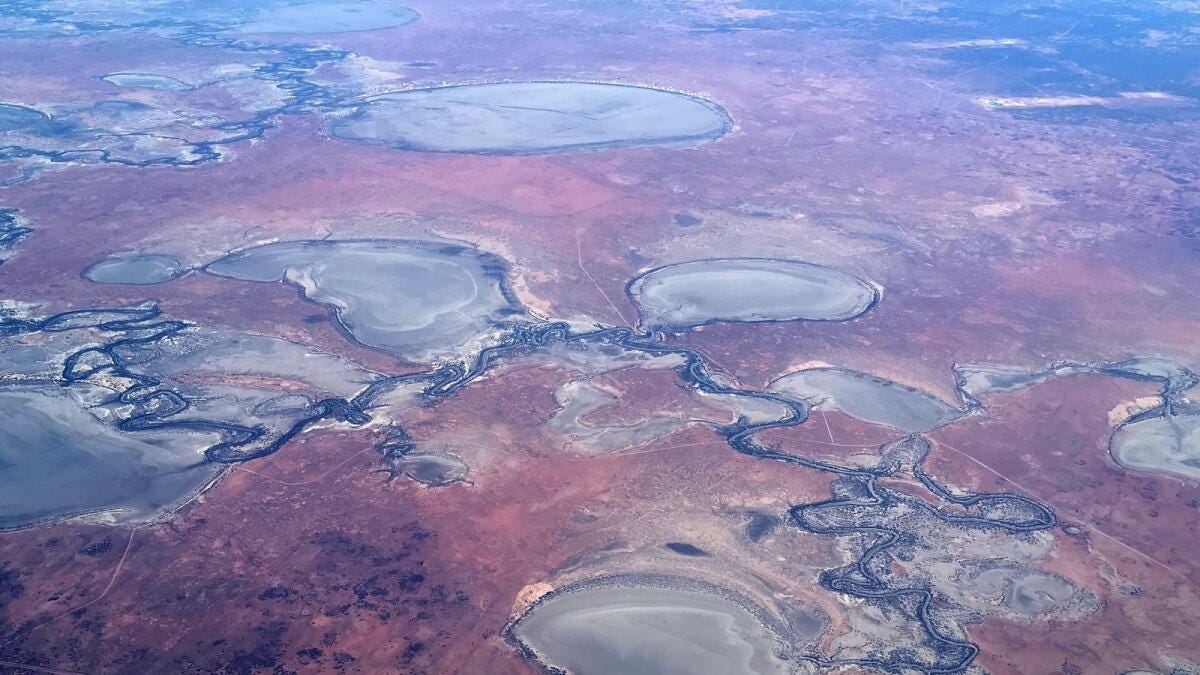Kati Thanda’s Mirage: Why a Full Lake Eyre Doesn’t Point to a Big Snow Season
Prompted by questions from our readers — and a recent article by Stuart Browning at Risk Frontiers — this piece unpacks a persistent myth: does a full Kati Thanda–Lake Eyre signal a big snow season?
Kati Thanda–Lake Eyre, Australia’s largest lake when full, often sparks curiosity and speculation, especially when it holds water. One of the more persistent myths is that a full Lake Eyre signals a bumper ski season for the Australian Alps.
Two schools of thought steer this belief: first, that moisture from the lake might be a catalyst for weather systems that reach the mountains, and second, that a full lake hints at a broader climate pattern favouring increased snowfall in the High Country. Both sound plausible, but peer-reviewed science tells a different story. Whilst the following is not anecdotal for the Snowy Mountains exclusively, there is conclusive evidence to suggest the event does not explicitly increase the chances of better than average snow season.
1. Can Lake Eyre Trigger Snow or Storms Through Evaporation?
The idea here is that when Lake Eyre is full, evaporation from the water surface might help generate clouds, storms, or even precipitation, much like the well-known lake-effect snow seen in places like North America. But central Australia doesn’t work that way. A 2023 study by Yang et al. in Geophysical Research Letters tested this exact scenario using climate modelling: what happens if Lake Eyre is permanently full? Their results demonstrated that evaporation from the lake cools the air near the surface, which reduces the rising motion needed for cloud formation, making precipitation less likely, not more.
Furthermore, observational and modelling studies from the North American Great Lakes region—where true lake-effect snow is well-documented—show that its influence typically extends no more than 100 to 150 km inland, with rare cases reaching up to 200-500 km (Niziol et al., 1995; Laird et al., 2009). In contrast, the Australian Alps lie over 700 km east–southeast of Kati Thanda–Lake Eyre, a distance far beyond the reach of any such moisture-enriched influence. Simply put, the spatial separation is too great for Lake Eyre to make a meaningful contribution to alpine precipitation processes.

2. Does a Full Lake Eyre Mean a Wetter or Snowier Year for the Alps?
Here, the logic is backward. Lake Eyre fills during wet years, so it’s easy to assume it predicts more wet weather — including snow in the mountains. But Kati Thanda is not a climate driver; it’s a climate responder. A 2004 modelling study led by Dr Pandora Hope at the Bureau of Meteorology, published in the Australian Meteorological Magazine, tested this idea by simulating a full Lake Eyre and measuring the rainfall response across the country. Their findings? No consistent or significant changes in rainfall patterns occurred outside the immediate lake region
Moreover, the region's moisture recycling ratio—a measure of how efficiently local evaporation contributes to rainfall—is highest in summer and autumn, but very low in winter (Hope & Nicholls, 2004). This further weakens the idea that Lake Eyre could contribute moisture to the snow season, as any local recycling potential peaks well outside the snow-bearing months.
We conclude, as did Warren (1945), that there is no evidence
that large-scale permanent water surfaces in inland Australia would
result in widespread climate amelioration. - Hope, et al. 2004
Despite popular speculation, there is no scientific basis for linking a full Kati Thanda–Lake Eyre with a stronger snow season in the Australian Alps. Both major studies—Hope et al. (2004) and Yang et al. (2023)—show that Lake Eyre’s influence on regional and downstream precipitation is negligible. Evaporation from the lake suppresses, rather than enhances, rainfall formation, and the presence of water in the lake reflects past rainfall events rather than driving future ones. In short, a full Lake Eyre is not a predictor, nor a producer, of alpine snow.
References:
Browning, 2025, Risk Frontiers: https://riskfrontiers.com/insights/climate-adaptation-australian-snowsports/
Hope, et al. 2004, Monash University: https://www.researchgate.net/publication/239585647_The_rainfall_response_to_permanent_inland_water_in_Australia
Laird et al., 2009, The Frequency and Characteristics of Lake-Effect Precipitation Events Associated with the New York State Finger Lakes: https://journals.ametsoc.org/view/journals/apme/48/4/2008jamc2054.1.xml
Niziol et al., 1995, Winter Weather Forecasting throughout the Eastern United States. Part IV: Lake Effect Snow: https://www.google.com/url?sa=t&source=web&rct=j&opi=89978449&url=http://www.appstate.edu/~perrylb/Courses/3600/Readings/Niziol_etal_1995.pdf
Thomas Measham et al. 2009: https://www.researchgate.net/figure/Lake-Eyre-Basin-study-area_fig1_228417348
Yang et al. 2023: Negligible Impact on Precipitation From a Permanent Inland Lake in Central Australia. https://agupubs.onlinelibrary.wiley.com/doi/full/10.1029/2023GL103913






Amazing! Thanks for following this up 🙂